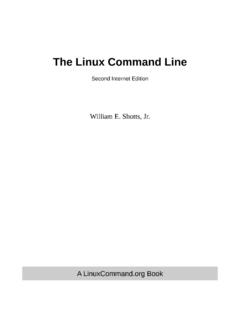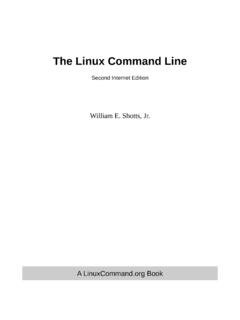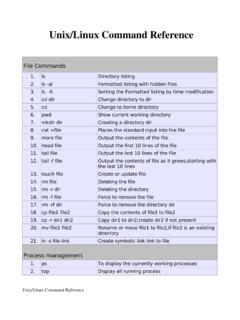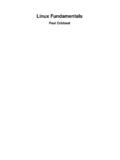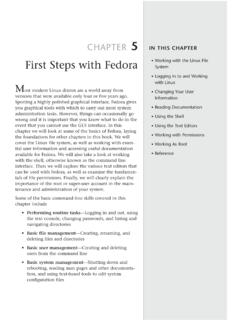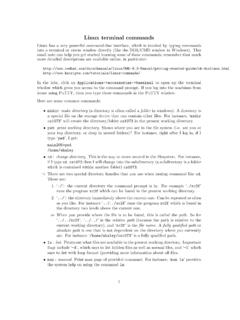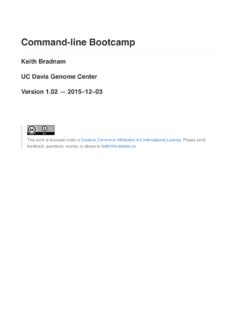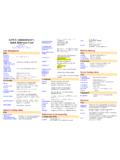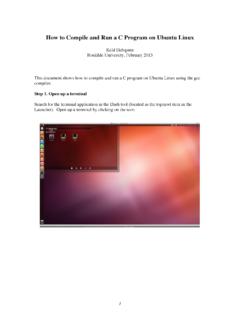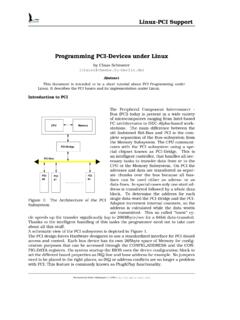Transcription of Lab – Working with Linux Command Line
1 2015 Cisco and/or its affiliates. All rights reserved. This document is Cisco Public. Page 1 of 9 Lab Working with Linux Command line Introduction In this lab, you will use the Linux Command line to manage files and folders and perform some basic administrative tasks. Recommended Equipment A computer with a Linux OS, either installed physically or in a virtual machineStep 1: Access the Command line . a. Log on to a computer as a user with administrative privileges. The account ITEUser is used as theexample user account throughout this access the Command line , click Dash, and type terminal in the search field and press Enter. Thedefault terminal emulator 2: Display the man pages from the Command line . You can display Command line help using the man Command .
2 A man page, short for manual page, is an online documentation of the Linux commands. A man page provides detailed information about a Command and all the available options. learn more about the man page, type man man at the Command prompt and press a few sections that included in a man page. b. Type q to exit the man Working with Linux Command line 2015 Cisco and/or its affiliates. All rights reserved. This document is Cisco Public. Page 2 of 9 man cp at the prompt to display the information about the cp Command would you use to find out more information about the pwd Command ? What is the function of the pwd Command ? Step 3: Create and change directories. In this step, you will use the change directory (cd), make directory (mkdir), and list directory (ls) commands.
3 Note: A directory is another word for folder. The terms directory and folder are used interchangeably throughout this lab. a. Type pwd at the prompt. What is the current directory? to the /home/ITEUser directory if it is not your current directory. Type cd / ls at the Command prompt to list the files and folders that are in the current In the current directory, use the mkdir Command to create three new folders: ITEfolder1, ITEfolder2, andITEfolder3. Type mkdir ITEfolder1 and press Enter. Create ITEfolder2 and ls to verify the folders have been Working with Linux Command line 2015 Cisco and/or its affiliates. All rights reserved. This document is Cisco Public. Page 3 of 9 cd ITEfolder3 at the Command prompt and press Enter.
4 Which folder are you in now?Another way to determine your location in the directory tree is to looking at the prompt. In this example, the prompt, ITEUser@iteuser-VirtualBox:~/ITEfolder3$ , provides the name of the current user, the computer name, the current Working directory, and the privilege level. ~/ITEfolder3: is the current Working directory. The symbol ~ represents the current user s home directory. In this example, it is /home/ITEUser. $: indicates regular user privilege. If # is displayed at the prompt, this indicates elevated privilege (root). the ITEfolder3 folder, create a folder named ITEfolder4. Type mkdir ITEfolder4. Use the lscommand to verify the folder Type cd .. to change the current directory. Each .. is a shortcut to move up one level in the directory issuing the cd.
5 Command , what is your directory now?What would be the current directory if you issue this Command at ITEUser@iteuser-VirtualBox:~$? Step 4: Create text files. to the /home/ITEUser/ITEfolder1 (~/ITEfolder1) directory. Type cd ITEfolder1 at the echo This is > at the Command prompt. The echo Command is used to display amessage at the Command prompt. The > is used to redirect the message from the screen to a file. Forexample, in the first line , the message This is is redirected into a new file named Usethe echo Command and > redirect to create these files: , , and the ls Command to verify the files are in the ITEfolder1 folder. To determine the file permission andother information, type the ls l Command at the Working with Linux Command line 2015 Cisco and/or its affiliates.
6 All rights reserved. This document is Cisco Public. Page 4 of 9 The following figure breaks down the information provided by the ls l Command . The user ITEUser is owner of file. The user can read and write to the file. The user ITEUser belongs to the group name ITEUser. Anyone in the group ITEUser has the same permission. The group can read and write to the file. If the user is not the owner or in the group ITEUser, the user can only read the file as indicated by the permission for other. the man ls Command at the prompt. What option would you use to list all the files in the directory,including the hidden files starting with .? the cat Command to view the content of the text files. To view the content of , type 5: Copy, delete, and move files.
7 The Command prompt, type mv ~/ITEfolder2 to move the file to the/home/ITEUser/ITEfolder2 directory. b. Type ls at the prompt to verify that is no longer in the current cd ../ITEfolder2 to change the directory to ITEfolder2. Type ls at the prompt to verify hasbeen Working with Linux Command line 2015 Cisco and/or its affiliates. All rights reserved. This document is Cisco Public. Page 5 of 9 d. Type cp to create a copy of Type ls at the prompt to verify a copy ofthe file has been created. Use the cat Command to look at the content of The content inthe copy should be the same as the original use the mv Command to move to ITEfolder1. Type mv Use the ls Command to verify that is no longer in the copy of can be created and renamed with the cp Command .
8 Type cp at the ls ../ITEfolder1 to view the content in ITEfolder1 without leaving the current the current directory to ITEfolder1. Type cd ../ITEfolder1 at the and into ITEfolder3. To move all the files that contain the word file into ITEfolder3 with one Command , use a wildcard (*) character to represent one or more characters. Type mv file*.txt .. delete from the ITEfolder1 directory. Type rm Use the ls commandto verify the file 6: Delete directories. In this step, you will delete a directory using the rm Command . The rm Command can be used to delete files and directories. to the /home/ITEUser/ITEfolder3 directory. Use the ls Command to list the content of Working with Linux Command line 2015 Cisco and/or its affiliates.
9 All rights reserved. This document is Cisco Public. Page 6 of 9 b. Use the rm ITEfolder4 to delete the empty directory, and the message rm: cannot remove ITEfodler4/ : Is a directory. c. Use the man pages to determine what options are necessary so the rm Command can delete directory. Type man rm at the prompt. What option is needed to delete a directory? d. Use the rm d ITEfolder4 Command to delete the empty directory and use the ls Command to verify the removal of the directory. e. Navigate to /home/ITEUser. f. Now remove the folder ITEfolder3 using the rm d ITEfolder3 Command to delete the non-empty directory. The message indicates that the directory is not empty and cannot be deleted. g. Use man pages to find out more information about the rm Command .
10 What option is necessary to delete a non-empty folder using the rm Command ? h. To remove a non-empty directory, type the rm r ITEfolder3 Command to delete the non-empty folder. Use the ls Command to verify that directory was deleted. Step 7: Print lines matching a pattern. The cat Command is used to view the content of a text file. To search the content of a text file, you can use the grep Command . The grep Command can also be used to match a pattern with screen outputs. In this step, you will create a few additional text files in the /home/ITEUser/ITEfolder1 directory. The content and the filename are of your choosing. Three text files are used as example in this step. a. Navigate to /home/ITEUser/ITEfolder1. Lab Working with Linux Command line 2015 Cisco and/or its affiliates.




